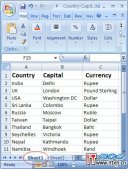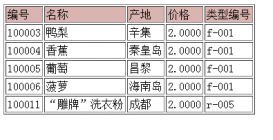导言:
本教程的Data Access Layer (DAL)使用的是类型化的数据集(Typed DataSets).就像我们在第一章《创建一个数据访问层》里探讨的一样,该类型化的数据集由强类型的DataTable和TableAdapter构成。DataTable描绘的是系统里的逻辑实体而TableAdapter引用相关数据库执行数据访问,包括对DataTable填充数据、执行返回标量数据(scalar data)的请求、添加,更新,删除数据库里的记录等.
TableAdapter执行的SQL命令要么是某个特定的SQL statements,比如SELECT columnList FROM TableName;要么是存储过程.本教程前面部分的TableAdapter使用的是SQL statements.不过很多开发者和数据库管理员基于安全、便于维护等方面的考虑,偏爱使用存储过程;不过也有的人出于灵活性的考虑偏爱使用SQL statement.就我自己而言,我也偏向于存储过程.在前面的文章,出于简化的目的我选用的是SQL statements.
当定义一个新TableAdapter或添加新方法时,使用TableAdapter的设置向导,我们可以很容易的创建新的或使用现有的存储过程.在本文,我们将考察如何使用设置向导自动的生产存储过程。在下一章我们考察如何设置TableAdapter的方法使用现有的或手动创建存储过程.
注意:关于讨论到底使用存储过程还是使用SQL statements的问题,可参考Rob Howard的博客文章《Don't Use Stored Procedures Yet?》(http://weblogs.asp.net/rhoward/archive/2003/11/17/38095.aspx)和Frans Bouma的博客文章《Stored Procedures are Bad, M'Kay?》(http://weblogs.asp.net/fboue/2003/11/18/38178.aspx)
存储过程基础
一个存储过程由一系列的T-SQL statement组成,当调用该存储过程时就执行这些T-SQL statement.存储过程可以接受0到多个输入参数,返回标量值、输出参数,或最常见的返回SELECT查询值.
注意:存储过程Stored procedures也经常引用为“sprocs” or “SPs”.
可以使用T-SQL statement语句CREATE PROCEDURE来创建存储过程.比如下面的T-SQL脚本创建了一个名为GetProductsByCategoryID的存储过程,它有一个名为 @CategoryID的参数,并且将表Products里与CategoryID值相吻合的那条记录的ProductID, ProductName, UnitPrice,以及Discontinued值返回.
|
1
2
3
4
5
6
7
8
9
|
CREATE PROCEDURE GetProductsByCategoryID( @CategoryID int)ASSELECT ProductID, ProductName, UnitPrice, DiscontinuedFROM ProductsWHERE CategoryID = @CategoryID |
创建后,我们可以用下面的代码调用它:
|
1
|
EXEC GetProductsByCategory categoryID |
注意:在下篇文章我们将在Visual Studio IDE集成环境里创建存储过程.不过在本文,我们将用TableAdapter向导来自动创建存储过程.
除了返回数据外,我们还可以在一个事务里用存储过程执行多条数据库命令.比如,假如有一个名为DeleteCategory的存储过程,其包含一个输入参数@CategoryID,并执行2个DELETE statemets,第一个是删除相关的products,第二个是删除category。存储过程里面的多个statements并不是自动的封装在一个事务里的.我们应添加额外的T-SQL commands以确保存储过程里的多条数据库命令当成原子操作处理.我们将在后面的内容考察如何用事务来封装存储过程的命令.
当在体系的某个层使用存储过程时,Data Access Layer的方法将调用某个具体的存储过程而不是发出一个SQL statement命令.这样一来我们可以发现、分析发出的查询命令.并可以更清楚的看到数据库是如何使用的.有关存储过程基本原理的更多信息,可参考本文结束部分的延伸阅读.
第一步:创建数据访问层高级场景的Web页面
在开始之前,让我们花点时间创建本文及后面几篇文章要用到的页面。新建一个名为AdvancedDAL的文件夹,然后添加如下的ASP.NET页面,记得使用母版页Site.master:
Default.aspx
NewSprocs.aspx
ExistingSprocs.aspx
JOINs.aspx
AddingColumns.aspx
ComputedColumns.aspx
EncryptingConfigSections.aspx
ManagedFunctionsAndSprocs.aspx
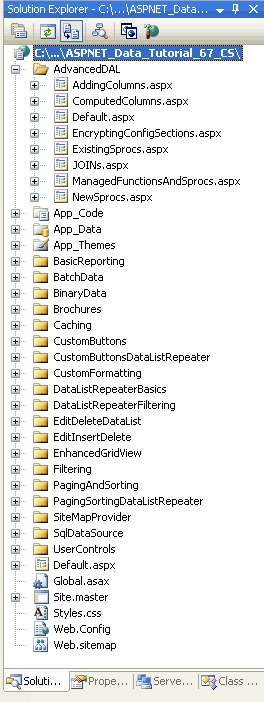
图1:添加相关的页面
像其它文件夹一样,Default.aspx页面将列出本部分的内容,记得SectionLevelTutorialListing.ascx用户控件提供了该功能。因此,将其从解决资源管理器里拖放到Default.aspx页面.
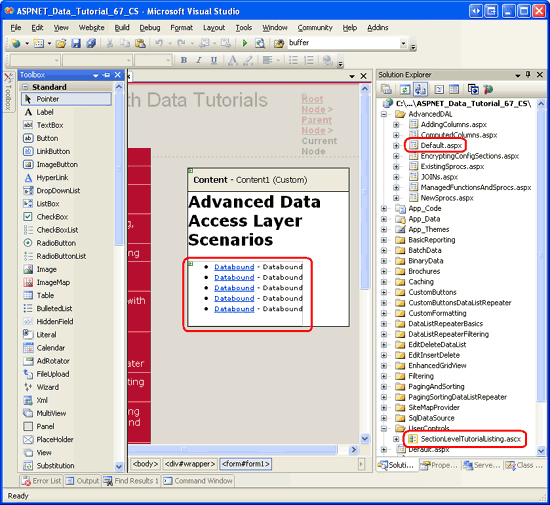
图2:将SectionLevelTutorialListing.ascx用户控件拖到Default.aspx页面
最后,将这些页面添加到Web.sitemap文件里。特别的,把下面的代码放在“Working with Batched Data”
<siteMapNode>标签后面:
|
1
2
3
4
5
6
7
8
9
10
11
12
13
14
15
16
17
18
19
20
21
22
23
24
25
26
27
28
29
30
31
32
|
<siteMapNode url="~/AdvancedDAL/Default.aspx" title="Advanced DAL Scenarios" description="Explore a number of advanced Data Access Layer scenarios."> <siteMapNode url="~/AdvancedDAL/NewSprocs.aspx" title="Creating New Stored Procedures for TableAdapters" description="Learn how to have the TableAdapter wizard automatically create and use stored procedures." /> <siteMapNode url="~/AdvancedDAL/ExistingSprocs.aspx" title="Using Existing Stored Procedures for TableAdapters" description="See how to plug existing stored procedures into a TableAdapter." /> <siteMapNode url="~/AdvancedDAL/JOINs.aspx" title="Returning Data Using JOINs" description="Learn how to augment your DataTables to work with data returned from multiple tables via a JOIN query." /> <siteMapNode url="~/AdvancedDAL/AddingColumns.aspx" title="Adding DataColumns to a DataTable" description="Master adding new columns to an existing DataTable." /> <siteMapNode url="~/AdvancedDAL/ComputedColumns.aspx" title="Working with Computed Columns" description="Explore how to work with computed columns when using Typed DataSets." /> <siteMapNode url="~/AdvancedDAL/EncryptingConfigSections.aspx" title="Protected Connection Strings in Web.config" description="Protect your connection string information in Web.config using encryption." /> <siteMapNode url="~/AdvancedDAL/ManagedFunctionsAndSprocs.aspx" title="Creating Managed SQL Functions and Stored Procedures" description="See how to create SQL functions and stored procedures using managed code." /></siteMapNode> |
更新Web.sitemap文件后,花点时间在浏览器里查看,左边的菜单将包括本部分的内容.
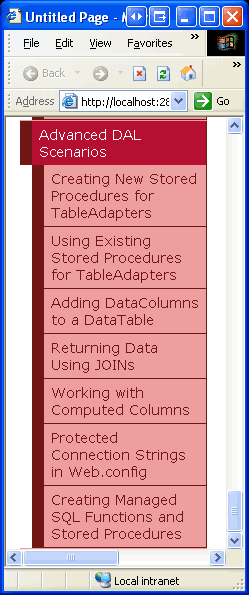
图3:网站地图现在包含了不部分的页面
第二步:设置TableAdapter创建新的存储过程
我们在~/App_Code/DAL文件夹里创建一个类型化的DataSet,名称为NorthwindWithSprocs.xsd.由于我们在以前的教程里已经详细探讨了创建细节,因此我们这里一笔带过,如果你想知道详细的创建过程请参阅前面的第1章《创建一个数据访问层》在DAL文件夹上右击鼠标选“添加新项”,选DataSet模板,如图4所示.

图4:新建一个名为NorthwindWithSprocs.xsd的数据集
这样将会创建一个新的类型化的DataSet,打开设计器,创建一个新的TableAdapter,展开TableAdapter设置向导.向导的第一步是让我们选择要连接的数据库.在下拉列表里有一个连接到Northwind数据库的连接字符串,选中它,再点下一步。接下来的界面让我们选择TableAdapter以哪种方式访问数据库.在以前的教程里我们选择的是“Use SQL statements”,不过在本文我们选第二项:“Create new stored procedures”,点下一步.
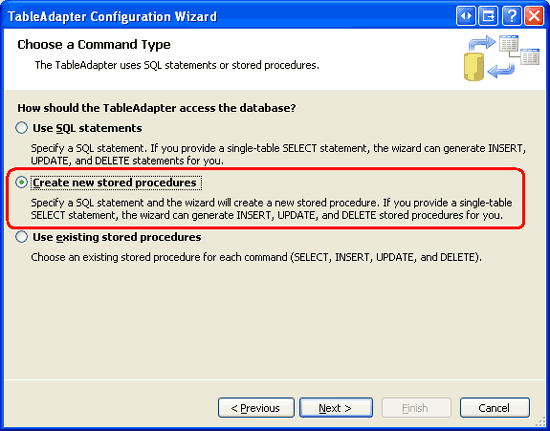
图5:设置TableAdpater创建新的存储过程
接下来,我们要指定主查询(main query).我们将创建一个存储过程来包含SELECT查询.
使用下面的SELECT查询:
|
1
2
3
4
|
SELECT ProductID, ProductName, SupplierID, CategoryID, QuantityPerUnit, UnitPrice, UnitsInStock, UnitsOnOrder, ReorderLevel, DiscontinuedFROM Products |
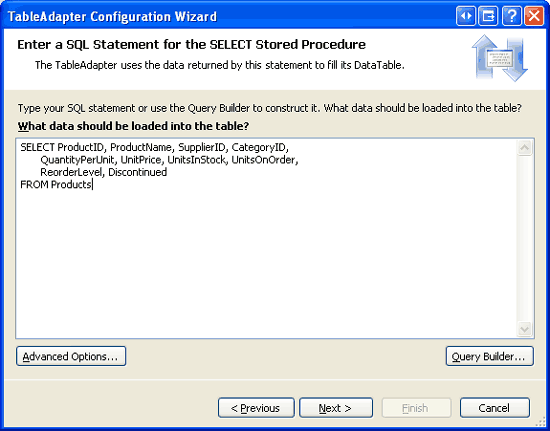
图6:键入SELECT查询
注意:在名为Northwind的数据集里的ProductsTableAdapter的主查询与上面本文定义的主查询有所不同。那个主查询还返回了每个产品的category名称和company名称.不过在后面的文章我们将对本文的TableAdapter添加这些相关的代码.再点“Advanced Options”按钮.我们可以指定是否让向导为TableAdapter自动生成insert, update和delete statements;是否使用开发式并发操作(optimistic concurrency);是否完成inserts 和 update操作后刷新数据表.在默认情况下,自动选中“Generate Insert, Update and Delete statements”选项。另外,本文不用选择“Use optimistic concurrency”项.当选择自动创建存储过程时,“Refresh the data table”项将被忽略掉.不管是否选中该项,最终的insert 和update存储过程都会检索刚添加或刚更新(just-inserted or just-updated record)的记录,我们将在第三步看到.

图7:选中“Generate Insert, Update and Delete statements”项
注意:当选中“Use optimistic concurrency”项的时候,向导会在WHERE语句里添加额外的条件,当其它列的值发生改动的话,将阻止数据更新.关于使用TableAdapter内置的optimistic concurrency功能请参阅第21章《实现开放式并发》输入SELECT主查询并选取“Generate Insert, Update and Delete statements”项后,点下一步,接下来的界面,如图8所示,让我们为selecting, inserting, updating, 和deleting数据的存储过程命名.将这些存储过程的名字改为Products_Select, Products_Insert, Products_Update, 和Products_Delete.
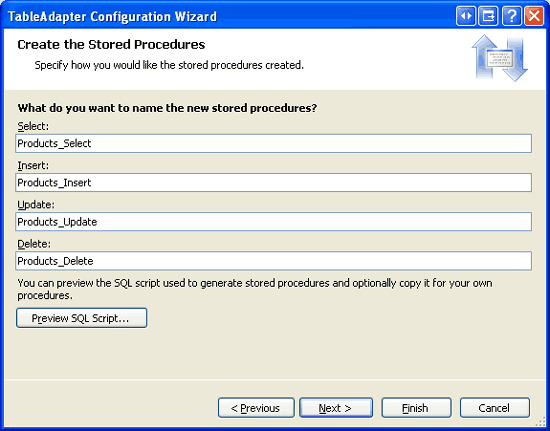
图8:为存储过程重命名
向导创建了4个存储过程,点“Preview SQL Script”按钮,你可以在Preview SQL Script 对话框里将脚本保存在一个文件里或复制到剪贴板.
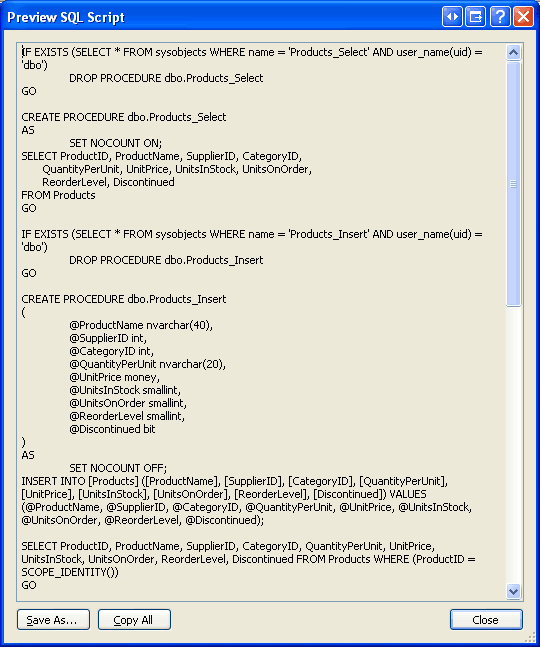
图9:预览生成的存储过程
对存储过程重命名后,点下一步,对TableAdapter相应的方法命名.就像使用SQL statements一样,我们可以创建方法来填充一个现有的DataTable或返回一个新的DataTable;我们也一个指定TableAdapter是否采用DB-Direct模式来插入、更新、删除记录.全选这3项,只不过将Return a DataTable方法重命名为GetProducts,如图10所示:
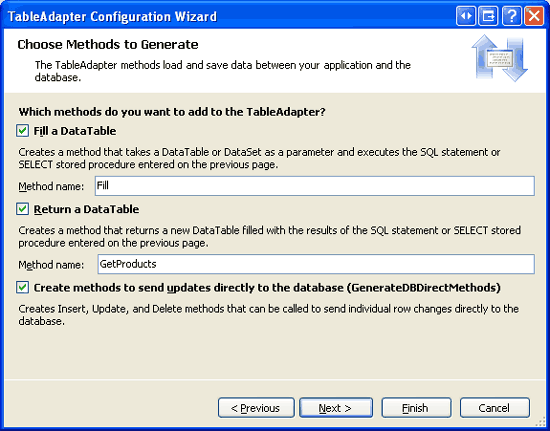
图10:将方法重命名为Fill 和GetProducts
点Next总览向导将执行的步骤.点Finish按钮完成设置.一旦向导结束后,将返回DataSet设计器,它此时将包括ProductsDataTable.
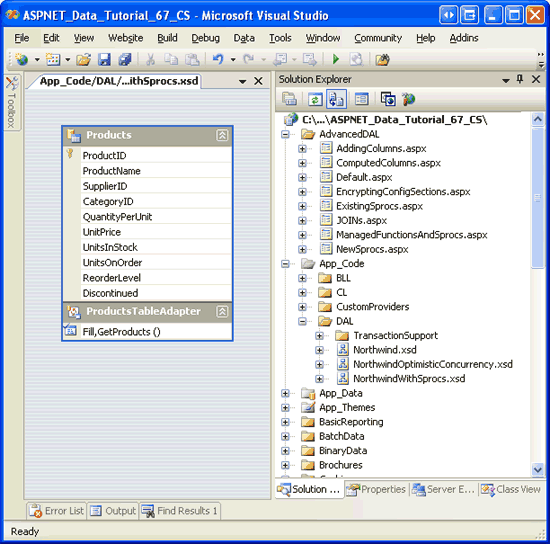
图11:DataSet设计器将显示刚刚添加的ProductsDataTable
第三步:考察刚刚创建的存储过程
我们在第二步里用向导创建了选择、插入、更新、删除数据的存储过程.这些存储过程可以通过Visual Studio查看或修改.打开服务器资源管理器,点到数据库的存储过程文件夹。如图12所示,Northwind数据库包含了4个新的存储过程,Products_Delete, Products_Insert, Products_Select, and Products_Update.
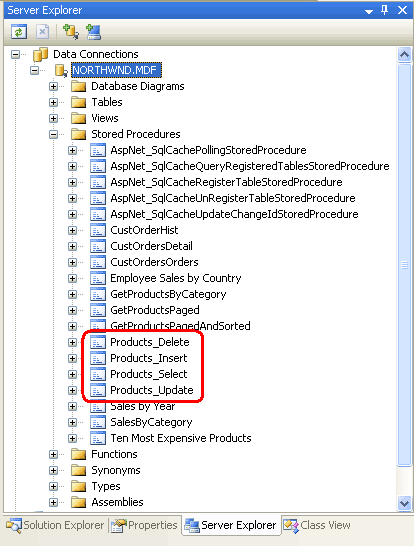
图12:可以在Stored Procedures文件夹里找到我们创建的4个存储过程
注意:如果你看不到服务器资源管理器,点“View”菜单,选Server Explorer项.如果你无法找到新创建的存储过程,右击Stored Procedures文件夹,选“刷新”.
要查看或修改某个存储过程,在服务器资源管理器里双击其名字或右击该存储过程,选”打开“。如13显示的是打开Products_Delete存储过程的画面.
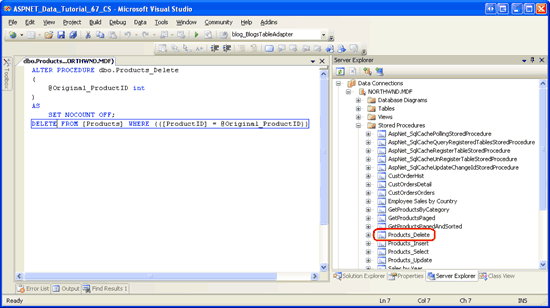
图13:可以在Visual Studio里打开并修改存储过程
Products_Delete和Products_Select存储过程的内容很好理解。比如下面的代码构成了Products_Insert存储过程.
|
1
2
3
4
5
6
7
8
9
10
11
12
13
14
15
16
17
18
19
20
21
22
23
|
ALTER PROCEDURE dbo.Products_Insert( @ProductName nvarchar(40), @SupplierID int, @CategoryID int, @QuantityPerUnit nvarchar(20), @UnitPrice money, @UnitsInStock smallint, @UnitsOnOrder smallint, @ReorderLevel smallint, @Discontinued bit)AS SET NOCOUNT OFF;INSERT INTO [Products] ([ProductName], [SupplierID], [CategoryID], [QuantityPerUnit], [UnitPrice], [UnitsInStock], [UnitsOnOrder], [ReorderLevel], [Discontinued])VALUES (@ProductName, @SupplierID, @CategoryID, @QuantityPerUnit, @UnitPrice, @UnitsInStock, @UnitsOnOrder, @ReorderLevel, @Discontinued); SELECT ProductID, ProductName, SupplierID, CategoryID, QuantityPerUnit, UnitPrice, UnitsInStock, UnitsOnOrder, ReorderLevel, DiscontinuedFROM ProductsWHERE (ProductID = SCOPE_IDENTITY()) |
在TableAdapter向导里定义的SELECT查询返回Products表里的列,这些列又作为存储过程的输入参数并运用到INSERT statement中.紧接着的是一个SELECT查询,返回Products表里最新添加的记录的各列的值(包括ProductID)。当使用Batch Update模式添加一个新记录时,刷新功能是很有用的。因为它将最新添加的ProductRow instances实例的ProductID属性赋值为数据库指派的自增值.
下面的代码说明了该功能.代码创建了基于NorthwindWithSprocs数据集的ProductsTableAdapter以及ProductsDataTable。要向数据库添加一个新的产品,我们要创建一个ProductsRow instance实例,对其赋值,并调用TableAdapter的Update方法,再传递给ProductsDataTable.在内部,TableAdapter的Update方法遍历传递给DataTable的所有ProductsRow instance实例(在本例,只有一个。因为我们只添加了一个产品),并执行相应的insert, update, 或delete命令。此时,执行Products_Insert存储过程,其向Products表添加一条新记录,并返回该记录的详细信息,然后更新ProductsRow instance实例的ProductID值。Update方法完成后,我们就可以通过ProductsRow的ProductID属性访问新添加记录的ProductID值了.
|
1
2
3
4
5
6
7
8
9
10
11
12
13
14
15
16
17
18
19
20
|
// Create the ProductsTableAdapter and ProductsDataTableNorthwindWithSprocsTableAdapters.ProductsTableAdapter productsAPI = new NorthwindWithSprocsTableAdapters.ProductsTableAdapter();NorthwindWithSprocs.ProductsDataTable products = new NorthwindWithSprocs.ProductsDataTable();// Create a new ProductsRow instance and set its propertiesNorthwindWithSprocs.ProductsRow product = products.NewProductsRow();product.ProductName = "New Product";product.CategoryID = 1; // Beveragesproduct.Discontinued = false;// Add the ProductsRow instance to the DataTableproducts.AddProductsRow(product);// Update the DataTable using the Batch Update patternproductsAPI.Update(products);// At this point, we can determine the value of the newly-added record's ProductIDint newlyAddedProductIDValue = product.ProductID; |
类似的,Products_Update存储过程的UPDATE statement后面也包含一个SELECT statement,如下:
|
1
2
3
4
5
6
7
8
9
10
11
12
13
14
15
16
17
18
19
20
21
22
23
24
25
26
27
28
|
ALTER PROCEDURE dbo.Products_Update( @ProductName nvarchar(40), @SupplierID int, @CategoryID int, @QuantityPerUnit nvarchar(20), @UnitPrice money, @UnitsInStock smallint, @UnitsOnOrder smallint, @ReorderLevel smallint, @Discontinued bit, @Original_ProductID int, @ProductID int)AS SET NOCOUNT OFF;UPDATE [Products]SET [ProductName] = @ProductName, [SupplierID] = @SupplierID, [CategoryID] = @CategoryID, [QuantityPerUnit] = @QuantityPerUnit, [UnitPrice] = @UnitPrice, [UnitsInStock] = @UnitsInStock, [UnitsOnOrder] = @UnitsOnOrder, [ReorderLevel] = @ReorderLevel, [Discontinued] = @DiscontinuedWHERE (([ProductID] = @Original_ProductID)); SELECT ProductID, ProductName, SupplierID, CategoryID, QuantityPerUnit, UnitPrice, UnitsInStock, UnitsOnOrder, ReorderLevel, DiscontinuedFROM ProductsWHERE (ProductID = @ProductID) |
我们注意到该存储过程有2个关于ProductID的参数,即@Original_ProductID 和@ProductID,这样以来我们就可以对主键值进行改动了.举个例子:有一个employee(雇员)数据库,每条employee记录都用雇员的社保号码作为其主键值.要想更改某条记录的社保号码,必须提供新的号码以及原始号码.不过对Products表来说用不着,因为列ProductID是一个唯一标识列(IDENTITY column),不应对其更改.实际上,Products_Update存储过程里的UPDATE statement并没有包含ProductID列,因此,如果在UPDATE statement的WHERE字句里使用@Original_ProductID的话,显得多此一举,而应该使用@ProductID参数.当更新某个存储过程的参数时,TableAdapter里所有那些调用该存储过程方法都应该进行更新.
第四步:修改存储过程的参数并更新TableAdapter
由于@Original_ProductID参数是多余的,让我们将其从Products_Update存储过程里完全清除.打开Products_Update存储过程,删除@Original_ProductID参数,在UPDATE statement的WHERE字句里将@Original_ProductID改为@ProductID. 完成上述修改后,该存储过程里的T-SQL看起来应该和下面的差不多:
|
1
2
3
4
5
6
7
8
9
10
11
12
13
14
15
16
17
18
19
20
21
22
23
24
25
26
|
ALTER PROCEDURE dbo.Products_Update( @ProductName nvarchar(40), @SupplierID int, @CategoryID int, @QuantityPerUnit nvarchar(20), @UnitPrice money, @UnitsInStock smallint, @UnitsOnOrder smallint, @ReorderLevel smallint, @Discontinued bit, @ProductID int)AS SET NOCOUNT OFF;UPDATE [Products] SET [ProductName] = @ProductName, [SupplierID] = @SupplierID, [CategoryID] = @CategoryID, [QuantityPerUnit] = @QuantityPerUnit, [UnitPrice] = @UnitPrice, [UnitsInStock] = @UnitsInStock, [UnitsOnOrder] = @UnitsOnOrder, [ReorderLevel] = @ReorderLevel, [Discontinued] = @DiscontinuedWHERE (([ProductID] = @ProductID)); SELECT ProductID, ProductName, SupplierID, CategoryID, QuantityPerUnit, UnitPrice, UnitsInStock, UnitsOnOrder, ReorderLevel, DiscontinuedFROM ProductsWHERE (ProductID = @ProductID) |
按Ctrl+S或点工具栏里的“保存”图标,保存更改.此时,Products_Update存储过程不会执行@Original_ProductID参数,但TableAdapter仍然会传递该参数.要想查看TableAdapter传递给Products_Update存储过程的参数,你可以在设计器里选中TableAdapter,转到属性窗口,点更新命令的参数集(UpdateCommand'sParameters collection)里的椭圆型区域,这样将转到Parameters Collection Editor对话框,如图14所示:

图14:对话框里列出了传递给Products_Update存储过程的参数
要删除参数,只需选中它,再点Remove按钮.
要刷新参数的话,你也可以在设计器里选中TableAdapter,点右键选“设置”,这将会开启TableAdapter设置向导,它列出了用于select, insert, updat和delete的存储过程,并列出了这些存储过程的输入参数.如果你在Update下拉列表里选Products_Update的话,你可以看到该存储过程包含的输入参数里已经没有包含@Original_ProductID了(见图15),点Finish将对TableAdapter使用的参数集自动更新.

图15:你可以通过使用TableAdapter的设置向导来刷新参数集
第五步:添加额外的TableAdapter方法
我们在第二步说过,当创建一个新的TableAdapter时,很容易自动地生成相应的存储过程,同样我们也可以向TableAdapter添加额外的方法.作为演示,让我们向ProductsTableAdapter添加一个方法GetProductByProductID(productID),该方法将一个ProductID作为输入参数,并返回该产品的详细信息.在ProductsTableAdapter上点击右键,选择“添加查询”.
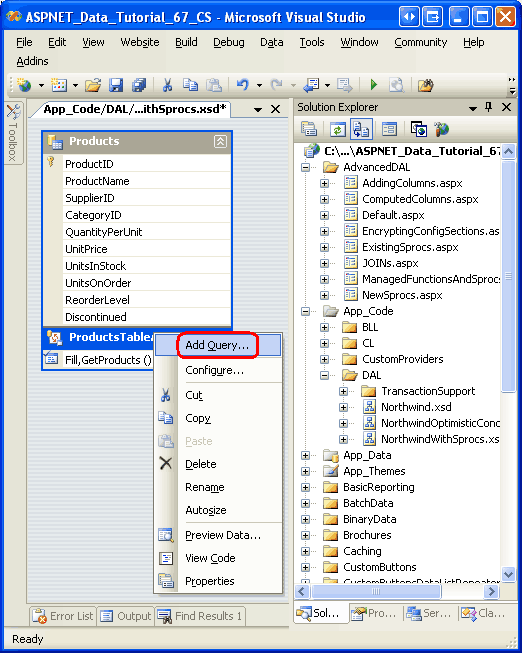
图16:向TableAdapter添加新查询
这将开启TableAdapter查询设置向导。首先,向导将询问以何种方式访问数据库,我们将创建一个新的存储过程,因此选“Create a new stored procedure”,再点Next.

图17:选中“Create a new stored procedure”项
接下来,向导询问我们执行哪种查询,是返回一系列行?一个标量值?又或者执行UPDATE, INSERT,或 DELETE statement.由于GetProductByProductID(productID)方法将返回一行,我们选择“SELECT which returns row”项,再点Next.
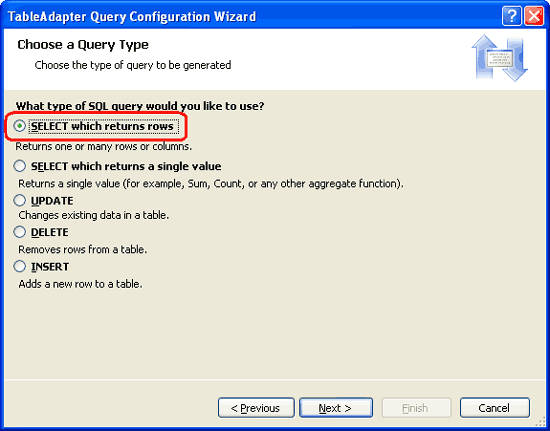
图18:选择“SELECT which returns row” 项
接下来的界面将展示TableAdapter的主查询,其仅仅列出了存储过程的名字(也就是dbo.Products_Select).将其删除,替换为如下的SELECT statement,它返回某个具体产品的所有列.
|
1
2
3
4
5
|
SELECT ProductID, ProductName, SupplierID, CategoryID, QuantityPerUnit, UnitPrice, UnitsInStock, UnitsOnOrder, ReorderLevel, DiscontinuedFROM ProductsWHERE ProductID = @ProductID |
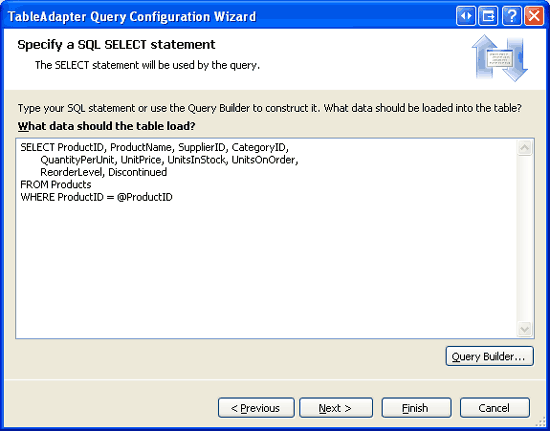
图19:将存储过程的名字替换为一个SELECT查询.
接下来要对创建的存储过程命名,输入Products_SelectByProductID,点Next.
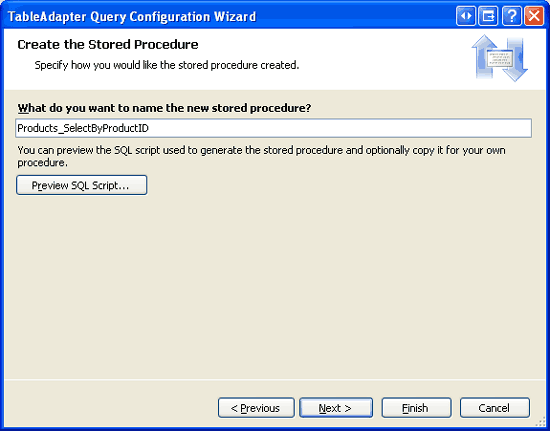
图20:将新存储过程命名为Products_SelectByProductID
最后一步将要我们对自动生成的名字重新命名,并指定是否使用Fill a DataTable模式、是否使用Return a DataTable模式,抑或这2种模式都采用.就本文而言,都选中这2项并将方法重命名为FillByProductID 和 GetProductByProductID.点Next,再点Finish完成设置向导.
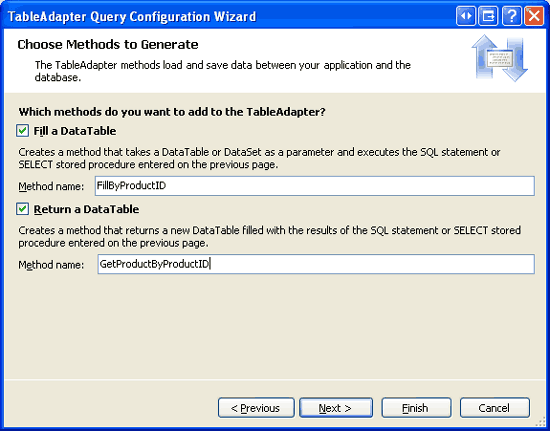
图21:将TableAdapter的方法重命名为FillByProductID 和 GetProductByProductID
完成向导后,TableAdapter将包含一个新的可用方法——GetProductByProductID(productID),当调用该方法时,将执行我们刚刚创建的Products_SelectByProductID存储过程.花点时间在服务器资源管理器里查看该存储过程,点Stored Procedures文件夹,并打开Products_SelectByProductID(如果你没看到它,在Stored Procedures文件夹上右击鼠标,选“刷新”).
请注意,SelectByProductID存储过程将@ProductID作为输入参数,并执行我们在向导里输入的SELECT Statement,如下:
|
1
2
3
4
5
6
7
8
9
10
11
12
|
ALTER PROCEDURE dbo.Products_SelectByProductID( @ProductID int)AS SET NOCOUNT ON;SELECT ProductID, ProductName, SupplierID, CategoryID, QuantityPerUnit, UnitPrice, UnitsInStock, UnitsOnOrder, ReorderLevel, DiscontinuedFROM ProductsWHERE ProductID = @ProductID |
第六步:创建一个业务逻辑层类
在我们打算从表现层访问产品前,我们首先需要为新添加的数据集创建一个BLL class,在~/App_Code/BLL文件夹里创建一个ProductsBLLWithSprocs.cs文件,如下:
|
1
2
3
4
5
6
7
8
9
10
11
12
13
14
15
16
17
18
19
20
21
22
23
24
25
26
27
28
29
30
31
32
33
34
35
36
37
38
39
40
41
42
43
44
45
46
47
48
49
50
51
52
53
54
55
56
57
58
59
60
61
62
63
64
65
66
67
68
69
70
71
72
73
74
75
76
77
78
79
80
81
82
83
84
85
86
87
88
89
90
91
92
93
94
95
96
97
98
99
100
101
102
103
104
105
106
107
108
109
110
111
112
113
114
115
116
117
118
119
120
121
122
123
124
125
126
127
128
129
130
131
132
133
134
135
136
137
138
139
140
141
142
143
144
145
146
147
148
149
150
151
152
153
154
155
156
|
using System;using System.Data;using System.Configuration;using System.Web;using System.Web.Security;using System.Web.UI;using System.Web.UI.WebControls;using System.Web.UI.WebControls.WebParts;using System.Web.UI.HtmlControls;using NorthwindWithSprocsTableAdapters;[System.ComponentModel.DataObject]public class ProductsBLLWithSprocs{ private ProductsTableAdapter _productsAdapter = null; protected ProductsTableAdapter Adapter { get { if (_productsAdapter == null) _productsAdapter = new ProductsTableAdapter(); return _productsAdapter; } } [System.ComponentModel.DataObjectMethodAttribute (System.ComponentModel.DataObjectMethodType.Select, true)] public NorthwindWithSprocs.ProductsDataTable GetProducts() { return Adapter.GetProducts(); } [System.ComponentModel.DataObjectMethodAttribute (System.ComponentModel.DataObjectMethodType.Select, false)] public NorthwindWithSprocs.ProductsDataTable GetProductByProductID(int productID) { return Adapter.GetProductByProductID(productID); } [System.ComponentModel.DataObjectMethodAttribute (System.ComponentModel.DataObjectMethodType.Insert, true)] public bool AddProduct (string productName, int? supplierID, int? categoryID, string quantityPerUnit, decimal? unitPrice, short? unitsInStock, short? unitsOnOrder, short? reorderLevel, bool discontinued) { // Create a new ProductRow instance NorthwindWithSprocs.ProductsDataTable products = new NorthwindWithSprocs.ProductsDataTable(); NorthwindWithSprocs.ProductsRow product = products.NewProductsRow(); product.ProductName = productName; if (supplierID == null) product.SetSupplierIDNull(); else product.SupplierID = supplierID.Value; if (categoryID == null) product.SetCategoryIDNull(); else product.CategoryID = categoryID.Value; if (quantityPerUnit == null) product.SetQuantityPerUnitNull(); else product.QuantityPerUnit = quantityPerUnit; if (unitPrice == null) product.SetUnitPriceNull(); else product.UnitPrice = unitPrice.Value; if (unitsInStock == null) product.SetUnitsInStockNull(); else product.UnitsInStock = unitsInStock.Value; if (unitsOnOrder == null) product.SetUnitsOnOrderNull(); else product.UnitsOnOrder = unitsOnOrder.Value; if (reorderLevel == null) product.SetReorderLevelNull(); else product.ReorderLevel = reorderLevel.Value; product.Discontinued = discontinued; // Add the new product products.AddProductsRow(product); int rowsAffected = Adapter.Update(products); // Return true if precisely one row was inserted, otherwise false return rowsAffected == 1; } [System.ComponentModel.DataObjectMethodAttribute (System.ComponentModel.DataObjectMethodType.Update, true)] public bool UpdateProduct (string productName, int? supplierID, int? categoryID, string quantityPerUnit, decimal? unitPrice, short? unitsInStock, short? unitsOnOrder, short? reorderLevel, bool discontinued, int productID) { NorthwindWithSprocs.ProductsDataTable products = Adapter.GetProductByProductID(productID); if (products.Count == 0) // no matching record found, return false return false; NorthwindWithSprocs.ProductsRow product = products[0]; product.ProductName = productName; if (supplierID == null) product.SetSupplierIDNull(); else product.SupplierID = supplierID.Value; if (categoryID == null) product.SetCategoryIDNull(); else product.CategoryID = categoryID.Value; if (quantityPerUnit == null) product.SetQuantityPerUnitNull(); else product.QuantityPerUnit = quantityPerUnit; if (unitPrice == null) product.SetUnitPriceNull(); else product.UnitPrice = unitPrice.Value; if (unitsInStock == null) product.SetUnitsInStockNull(); else product.UnitsInStock = unitsInStock.Value; if (unitsOnOrder == null) product.SetUnitsOnOrderNull(); else product.UnitsOnOrder = unitsOnOrder.Value; if (reorderLevel == null) product.SetReorderLevelNull(); else product.ReorderLevel = reorderLevel.Value; product.Discontinued = discontinued; // Update the product record int rowsAffected = Adapter.Update(product); // Return true if precisely one row was updated, otherwise false return rowsAffected == 1; } [System.ComponentModel.DataObjectMethodAttribute (System.ComponentModel.DataObjectMethodType.Delete, true)] public bool DeleteProduct(int productID) { int rowsAffected = Adapter.Delete(productID); // Return true if precisely one row was deleted, otherwise false return rowsAffected == 1; }} |
该类和以前章节所创建的ProductsBLL class类差不多,只是它用的是数据集 NorthwindWithSprocs的ProductsTableAdapter 和 ProductsDataTable object对象。与ProductsBLL类使用using NorthwindTableAdapters不同,ProductsBLLWithSprocs类使用的是using NorthwindWithSprocsTableAdapters.同样的,该类的ProductsDataTable和 ProductsRow对象使用的是NorthwindWithSprocs命名空间.我们的ProductsBLLWithSprocs class类提供了2种数据访问方法GetProducts() 和GetProductByProductID().另外,还有添加、更新、删除单个产品的方法.
第七步:在表现层出来数据集NorthwindWithSprocs
此时,我们以及对数据访问层和业务逻辑层做了相关改动,接下来我们要创建一个ASP.NET页面调用BLL的ProductsBLLWithSprocs class类以展示、更新、删除记录.
打开AdvancedDAL文件夹里的NewSprocs.aspx页面,从工具箱拖一个GridView控件到页面,设置其ID为Products. 从GridView的智能标签将其绑定到一个名为ProductsDataSource的ObjectDataSource,设置其调用ProductsBLLWithSprocs类.
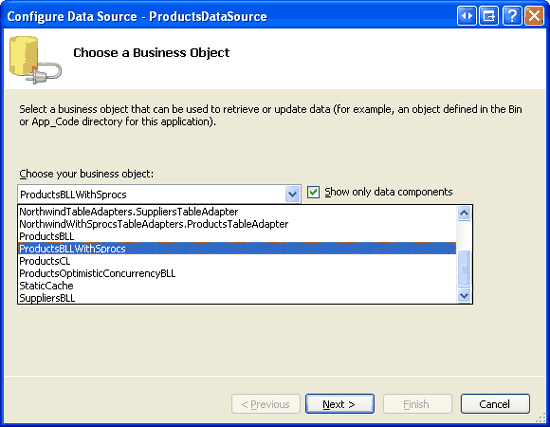
图22:设置ObjectDataSource调用ProductsBLLWithSprocs类
SELECT标签的下拉列表里有2个方法,GetProducts()和GetProductByProductID().由于我们将在GridView里显示所有的产品,所以我们选GetProducts()方法.在UPDATE, INSERT, 和DELETE标签里都只有一个方法,确保选中它们,点Finish按钮。
完成设置后,Visual Studio会向GridView添加BoundFields列以及一个CheckBoxField列, 启用GridView控件的“编辑”和“删除”功能.

图23:页面包含一个可以分页和排序的GridView控件.
就像在以前的教程里探讨过的一样,完成ObjectDataSource的设置后,Visual Studio 会自动的将OldValuesParameterFormatString属性设置为“original_{0}”. 为使数据修改功能正常工作,要么将该属性删除,要么将其设置为“{0}”.
在我们完成设置、启用“编辑”和“删除”功能、将OldValuesParameterFormatString属性设为其默认值后,页面的声明代码看起来应该和下面的差不多:
|
1
2
3
4
5
6
7
8
9
10
11
12
13
14
15
16
17
18
19
20
21
22
23
24
25
26
27
28
29
30
31
32
33
34
35
36
37
38
39
40
41
42
43
44
45
46
47
48
49
50
51
52
53
54
55
56
57
58
59
|
<asp:GridView ID="Products" runat="server" AutoGenerateColumns="False" DataKeyNames="ProductID" DataSourceID="ProductsDataSource"> <Columns> <asp:CommandField ShowDeleteButton="True" ShowEditButton="True" /> <asp:BoundField DataField="ProductID" HeaderText="ProductID" InsertVisible="False" ReadOnly="True" SortExpression="ProductID" /> <asp:BoundField DataField="ProductName" HeaderText="ProductName" SortExpression="ProductName" /> <asp:BoundField DataField="SupplierID" HeaderText="SupplierID" SortExpression="SupplierID" /> <asp:BoundField DataField="CategoryID" HeaderText="CategoryID" SortExpression="CategoryID" /> <asp:BoundField DataField="QuantityPerUnit" HeaderText="QuantityPerUnit" SortExpression="QuantityPerUnit" /> <asp:BoundField DataField="UnitPrice" HeaderText="UnitPrice" SortExpression="UnitPrice" /> <asp:BoundField DataField="UnitsInStock" HeaderText="UnitsInStock" SortExpression="UnitsInStock" /> <asp:BoundField DataField="UnitsOnOrder" HeaderText="UnitsOnOrder" SortExpression="UnitsOnOrder" /> <asp:BoundField DataField="ReorderLevel" HeaderText="ReorderLevel" SortExpression="ReorderLevel" /> <asp:CheckBoxField DataField="Discontinued" HeaderText="Discontinued" SortExpression="Discontinued" /> </Columns></asp:GridView><asp:ObjectDataSource ID="ProductsDataSource" runat="server" DeleteMethod="DeleteProduct" InsertMethod="AddProduct" SelectMethod="GetProducts" TypeName="ProductsBLLWithSprocs" UpdateMethod="UpdateProduct"> <DeleteParameters> <asp:Parameter Name="productID" Type="Int32" /> </DeleteParameters> <UpdateParameters> <asp:Parameter Name="productName" Type="String" /> <asp:Parameter Name="supplierID" Type="Int32" /> <asp:Parameter Name="categoryID" Type="Int32" /> <asp:Parameter Name="quantityPerUnit" Type="String" /> <asp:Parameter Name="unitPrice" Type="Decimal" /> <asp:Parameter Name="unitsInStock" Type="Int16" /> <asp:Parameter Name="unitsOnOrder" Type="Int16" /> <asp:Parameter Name="reorderLevel" Type="Int16" /> <asp:Parameter Name="discontinued" Type="Boolean" /> <asp:Parameter Name="productID" Type="Int32" /> </UpdateParameters> <InsertParameters> <asp:Parameter Name="productName" Type="String" /> <asp:Parameter Name="supplierID" Type="Int32" /> <asp:Parameter Name="categoryID" Type="Int32" /> <asp:Parameter Name="quantityPerUnit" Type="String" /> <asp:Parameter Name="unitPrice" Type="Decimal" /> <asp:Parameter Name="unitsInStock" Type="Int16" /> <asp:Parameter Name="unitsOnOrder" Type="Int16" /> <asp:Parameter Name="reorderLevel" Type="Int16" /> <asp:Parameter Name="discontinued" Type="Boolean" /> </InsertParameters></asp:ObjectDataSource> |
此时,我们可以对GridView控件做些修改,比如在编辑界面里使用确认控件,在CategoryID 和 SupplierID列放置DropDownList控件,当点击Delete按钮时弹出确认框等.由于在以前的教程我们探讨过这些主题,我不打算在此多花笔墨。
不管你做没做这些改进,让我们在浏览器里对页面测试,如图24所示.在GridView控件里每行都可以编辑和删除.
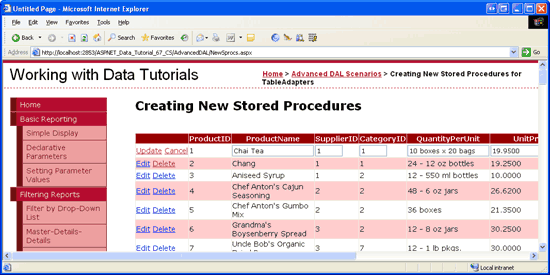
图24:可以通过GridView对产品进行查看、编辑、删除
结语:
类型化数据集里的TableAdapters可以通过ad-hoc SQL statement或存储过程访问数据库里的数据.当处理存储过程时,我们要么使用现有的存储过程,要么使用TableAdapter向导创建一个基于SELECT查询的新的存储过程.在本文,我们考察了如何自动的创建一个存储过程.
虽然自动创建可以节省时间,但是在某些情况下,向导自动创建的存储过程与我们的期望值还是有差距.比如自动创建的Products_Update存储过程,它包含@Original_ProductID 和 @ProductID这2个参数,但@Original_ProductID参数对我们来说是多余的.
在接下来的文章,我们将考察TableAdapter使用现有的存储过程的情况.
祝编程快乐!
作者简介
本系列教程作者 Scott Mitchell,著有六本ASP/ASP.NET方面的书,是4GuysFromRolla.com的创始人,自1998年以来一直应用 微软Web技术。希望对大家的学习ASP.NET有所帮助。


